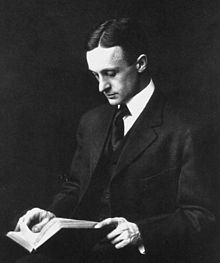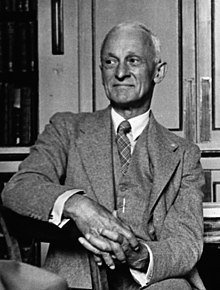Harvey Cushing
Harvey Williams Cushing [ ˈkʊʃɪŋ ] (born April 8, 1869 in Cleveland , Ohio , † October 7, 1939 in New Haven , Connecticut ) was an American brain surgeon and medical historian. He is considered the founder of modern neurosurgery .
family
Harvey Williams Cushing was born the youngest of ten children of the gynecologist Henry-Kirke Cushing and his wife Betsey Maria (Williams), he was the descendant of a family with a long medical tradition. In 1902 he married Katharine (Crowell), the marriage resulted in five children. His daughter Betsey Cushing Roosevelt Whitney became an art collector and her first marriage was General James Roosevelt . Cushing was buried in a grave of honor in Lake View Cemetery in his native Cleveland. The gravesite of the Rockefeller dynasty is in the immediate vicinity .
education and profession
After primary school in Cleveland, Cushing attended the prestigious Yale College from September 1887 . Even as a college student he showed his versatile talents: scientific, athletic, well-read and artistically gifted. In 1891 ( BA ) he went to Harvard Medical School in Boston to study medicine, among others with William Stewart Halsted , William Osler and William Henry Welch . In the second year of training Cushing attended the clinical lessons at Massachusetts General Hospital (MGH) in part and usually led the surgical preparation with ether - anesthesia by. An anesthetic incident occurred here, which motivated Cushing to search for ways to reduce lethal anesthesia: In 1895, Cushing and Ernest A. Codman (1869–1940) introduced an anesthetic protocol for anesthesia progress control, which included the most important parameters ( breathing , pulse , Temperature ) - a milestone in both surgery and Cushing's medical career.
In June 1895 he completed his medical studies with a doctorate ( cum laude ) from Harvard University and worked for a year as an assistant doctor at MGH 1896, he left Boston to work at the Johns Hopkins Hospital in Baltimore with the surgeon Halsted. He stayed there until 1900 and then went on a trip to Europe. In England he first met Osler and the brain surgeon Victor Horsley . He visited hospitals in France and Switzerland, worked with the Bern surgeon Theodor Kocher until March 1901 (where he was encouraged to pursue brain surgery after experiencing an unfortunate brain operation) and the physiologist Hugo Kronecker . Then he volunteered in the laboratory of the physiologist Angelo Mosso in Turin , where he dealt with the question of increases in blood pressure with increasing intracranial pressure. In Pavia , Cushing saw the Scipione Riva-Rocci blood pressure monitor in routine clinical operation for the first time . In Bern he met Hermann Sahli , in Germany he met Friedrich Daniel von Recklinghausen , Wilhelm Erb and Eduard Pflüger . Then he took part in animal studies in Liverpool with Charles Scott Sherrington .
Returned to the United States, he took up a clinical-surgical position at Johns Hopkins Hospital near Halsted, where he remained until 1912. Immediately after his trip to Europe, he developed a new anesthesia protocol in which the blood pressure was now also routinely recorded. The measurements themselves were carried out with a blood pressure monitor modified by Cushing . In the Baltimore years he specialized in neurosurgery, carried out important clinical blood pressure studies and examinations of physiological ( Ringer ) saline solution and founded the Hunterian Laboratory for Experimental Surgery.
From 1910 Cushing played a key role in the planning and construction of the Peter Bent Brigham Hospital in Boston ( Harvard Medical School ) and in 1912 he took over the Moseley Professorship for Surgery (until 1932) as well as the position of chief surgeon and established one of the most remarkable clinics in America. In 1914 he was elected to the American Academy of Arts and Sciences , in 1917 to the National Academy of Sciences and in 1930 to the American Philosophical Society . In 1923, the first intensive care unit in medical history began operating under his leadership. Cushing spent the spring of 1915 and 1917 with a team of doctors in Paris in the service of the American army. There he developed a tissue-conserving method for removing grenade or bullet fragments from injured areas of the brain: using an iron nail placed in front of a strong electromagnet, these could be pulled out through the gunshot or penetration channel after previous suctioning off tissue debris.
The neurosurgical clinic quickly gained worldwide renown and attracted doctors from all over the world, such as the French surgeons Clovis Vincent (1879–1947) and René Leriche . During his active time he was able to reduce the mortality of neurosurgical interventions from over 90% by 1931 to 7%. After more than 2000 brain tumor operations, Cushing gave up his position in Boston in 1932 for reasons of age. But you could win him for a professorship in neurology and medical history at Yale University, New Haven, which he represented until 1937. In 1932 he was elected a member of the Leopoldina .
power
Cushing was one of the greatest neurosurgeons of the 20th century. In addition, he introduced the anesthesia protocol for the mandatory control of vital functions, including routine blood pressure measurement . He was one of the first to use X-rays for medical diagnostics as early as the 1890s .
Cushing's scientific achievements are very diverse: hypophysectomy, reduction of surgical mortality from 90% to 6%, introduction of electrocautery , histological classification of brain tumors and spinal cord tumors, pituitary tumors (1912), tumors of the auditory nerves (1917), gliomas (1926), Physiology of the interior of the skull, brain surgery (1926), cerebral vascular tumors (1928), intracranial tumors (1932) and especially meningiomas (1938 with L. Eisenhardt). He was the first to describe Cushing's syndrome, which was named after him, and contributed to the study of acromegaly . In addition to the Cushing procedure as a surgical procedure and the Cushing clips , the Cushing ulcer and the Cushing reflex were named after him.
Cushing's time in Baltimore was strongly influenced by Osler, who was head of the internal department and was appointed Regius Professor to Oxford in 1905. A lifelong friendship developed between the two doctors. Cushing shared Osler's literary and bibliophile inclinations and, after his death, wrote the friend's biography, which was awarded the Pulitzer Prize (for biographies) in 1926 . Harvey Cushing collected old editions of medical books and medical history works and wrote about the history of medicine himself . He has published 13 books and more than 330 scientific articles, received 23 honorary doctorates, held presidencies in 7 and honorary memberships in 60 scientific societies and gave 16 internationally important award speeches. In 1930 he received the Lister Medal . Since 1960 he has given its name to Cushing Peak , a mountain on the Brabant Island in Antarctica.
Fonts (selection)
- On the avoidance of shock in major amputations by cocainization of large nerve-trunks preliminary to their division. With observations on blood-pressure changes in surgical cases. In: Ann Surg . 36, 1902, p. 321.
- Some experimental and clinical observations concerning states of increased intracranial tension. In: Am J Med Sci. 124, 1902, p. 396.
- On the routine determination of arterial tension in the operating room and clinic. In: Boston Med Surg J. 148, 1903, p. 250.
- The Life of Sir William Osler . 1925.
- From a surgeon's journal, 1915-1918 . Boston 1936.
- A Bio-Bibliography of Andreas Vesalius. Schuman's, New York 1943.
literature
- Aaron A. Cohen-Gadol, Dennis D. Spencer, American Association of Neurological Surgeons .; American Association of Neurosurgeons: The legacy of Harvey Cushing: profiles of patient care. Thieme, New York 2007.
- LF Haas: Harvey Williams Cushing (1869-1939). In: J Neurol Neurosurg Psychiatry. 73, 2002, p. 596.
- MK Davies, A. Hollman: Harvey Williams Cushing (1869-1939). In: Heart. 78, 1997, p. 212.
- LM Davey: Harvey Cushing and the Humanities in Medicine. In: J Hist Med. 24, 1969, p. 119.
- John Farquhar Fulton : Harvey Cushing 1869-1939. In: K. Kolle (Hrsg.): Grosse Nervenärzte . Volume 1, Stuttgart 1956, p. 57.
- John Farquhar Fulton: Harvey Cushing. A biography . Springfield 1946.
- John Farquhar Fulton: Harvey Cushing. In: W. Haymaker (Ed.): The founders of neurology . Springfield 1953, p. 415.
- EP Goldschmidt: A doctor and his books: Harvey Cushing and his library. In: J Hist Med. 1, 1946, p. 229.
- Harvey Cushing Society: A Bibliography of the Writings of Harvey Cushing, prepared on the Occasion of his Seventieth Birthday April 8, 1939 . Springfield 1939.
- Elizabeth H. Thomson: Harvey Cushing. Surgeon, author, artist . New York 1950.
Web links
- Literature by and about Harvey Cushing in the catalog of the German National Library
- biography
- Biography and eponyms whonamedit (English)
- Entry on Cushing, Harvey Williams (1869–1939) in the Archives of the Royal Society , London
Individual evidence
- ↑ Hans Rudolf Berndorff : A life for surgery. Obituary for Ferdinand Sauerbruch . In: Ferdinand Sauerbruch: That was my life. Kindler & Schiermeyer, Bad Wörishofen 1951; several new editions, e.g. licensed edition for Bertelsmann Lesering, Gütersloh 1956, pp. 456–478, here: p. 457.
- ^ Member History: Harvey Cushing. American Philosophical Society, accessed July 3, 2018 .
- ↑ German Society for Surgery: Central organ for the entire surgery and its border areas. Volumes 7-8, 1920, p. 346.
- ^ FF Burghard, Allen Buckner Kanavel: Oxford loose-leaf surgery. Volume 5, Oxford university press, 1921, p. 592.
- ↑ Sabine Schuchart: Harvey Cushing founded modern brain surgery Deutsches Ärzteblatt 1018, Volume 115, Issue 31-32 of August 6, 2018, page 92
- ↑ Elizabeth A. Brennan, Elizabeth C. Clarage: Who's who of Pulitzer Prize winners. Oryx Press, Phoenix, Ariz. 1999, p. 13.
| personal data | |
|---|---|
| SURNAME | Cushing, Harvey |
| ALTERNATIVE NAMES | Cushing, Harvey Williams (full name) |
| BRIEF DESCRIPTION | American neurosurgeon |
| DATE OF BIRTH | April 8, 1869 |
| PLACE OF BIRTH | Cleveland , Ohio, United States |
| DATE OF DEATH | October 7, 1939 |
| Place of death | New Haven , Connecticut, United States |

